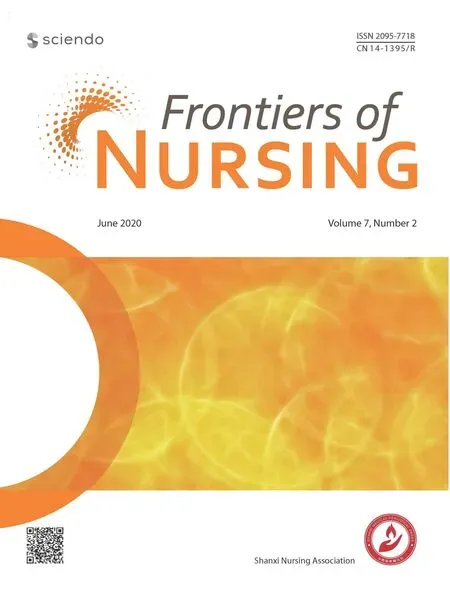Vertebral body infection due to esophageal perforation caused by ingestion of fishbone: a case report
Ling-Yun Zhng, Hong Ling, Xue-Guo Sun,*
a Department of Gastroenterology, The Affiliated Hospital of Qingdao University, Qingdao, Shandong 266000, China
bThe Community Healthcare Center of Yan'an'er Road, Qingdao, Shandong 266000, China
Abstract: Background: Esophageal injury is a common complication of foreign bodies in the upper gastrointestinal tract, but bilateral pleural effusion or vertebral infection is a rare condition due to a swallowed fishbone. It is considerably difficult for a physician to diagnose quickly because of incomplete patient history of foreign bodies ingestion and/or insufficient experiences.Patient concerns: We describe the case of a 56-year-old man who was admitted to an emergency medical department owing to a low to moderate fever for 7 days. After a series of examinations, the patient was diagnosed with esophageal perforation (EP) caused by a fishbone that was swallowed half a month ago.Diagnoses: About 12 days after the onset of fever, he was diagnosed with EP based on the gastric endoscopic images combined with histological section and sufficient history of the disease. About 2 months later, the patient has obvious back pain and lack of strength in two legs and was diagnosed with vertebral body infection.Interventions: Antibiotic therapy, multi-disciplinary team (MDT), and surgical intervention had been exerted.Outcomes: It is very fortunate for this patient to have a good prognosis due to a timely diagnosis and proper management. Muscle power has attained level 5.Lessons: Several lessons can be learned from this case; for example, physicians should be alerted to the EP, endoscopic intervention should be prompt, antibiotics should be used regularly, and so on.
Keywords: esophageal perforation · spinal infection · foreign body · operation
1. Introduction
Esophageal perforation (EP) was first described by Hermann Boerhaave who, in 1723, observed a spontaneous rupture of the esophagus occurring after repeated vomiting of an admiral in a Dutch Navy.1It was not until 1947 that Barrett and Olson made the first attempts at surgical repair of EP.2,3Despite update progress in intensive care, diagnostic methods, and endoscopic or surgical therapeutic measures of EP, the general mortality is still about 20%.4Diagnostic delays/errors due to frequent atypical clinical presentations/incomplete history, associated with the absence of clear management policies can partly explain this poor prognosis. Vertebral infection is a rare clinical condition with relatively atypical manifestations and slow progress. The esophageal penetration of a swallowed fishbone is a much rarer case, though fishbone is a common foreign body in the gastrointestinal tract. We present a case of vertebral body infection caused by fishbone perforation, which has seldom been reported in the English literature.
2. Case report
On September 23, 2016, a 56-year-old man consulted the emergency department for 7 days with unknown fever. The highest temperature was 38.5°C. Blood tests were as follows: WBC 7.75 × 109/L, NEUT 76.94%,CRP 120.57 mg/L, and procalcitonin 0.325 ng/ml. Posterior superior mediastinal masses with thickened adjacent esophagus wall and bilateral pleural effusion were revealed by thoracic computed tomography (CT) scan(Figure 1). A 1.0 cm × 2.0 cm protuberant mass was found in the left wall of the esophagus at 20 cm from the incisors by the gastric endoscopy (Figure 2). Endoscopic biopsy shows a chronic active inflammation with ulcer and granulation tissue proliferation. Examine the medical history in detail at that moment, the patient was diagnosed with an odynophagia and admitted that he had accidentally swallowed a fishbone 2 months ago. Taken together, the patient was diagnosed with secondary mediastinitis due to esophagus perforation caused by the ingestion of fishbone. The patient had been treated moxifloxacin intravenously for 15 days, and then he was discharged without fever. Obvious back pain and decreased muscle strength began on the 7th day after discharge.On November 10, he had a Magnetic resonance (MR) of the thoracic vertebra, and the result was C7/T1 centrum infection and paravertebral abscess (Figure 3). The surgical intervention had been performed 4 days later. Consequently, the back pain disappeared, the muscle strength recovered, and an MR reexamination showed the patient recovered completely (Figure 4).
3. Discussion
Fishbone is perhaps the most commonly ingested foreign body located in the upper gastrointestinal tract and causes EP in humans.4EP often led to a local infection of the esophagus, and mediastinitis would be developed with no proper treatment. Consequently,the infection might further spread to vertebral bodies as a rare clinical condition that many physicians cannot diagnose this condition timely. EP is a high-mortality condition, but early diagnosis and treatment can improve the prognosis.5The essential attribute of the diagnostic approach to esophageal rupture is the maintenance of a high index of suspicion.6Any patient who presents with fever or back pain weeks or even months after odynophagia should be aggressively evaluated,to rule out perforation of the esophagus. The first lesson from this case is that close endoscopic and radiologic follow-up is mandatory to ensure early diagnosis and proper treatment for EP. Next, antibiotic treatment should be performed with adequate dosage and duration. Finally, the infected tissues from the esophagus should be cultured for bacteria, mycobacteria, and fungi to guide treatment.
Ethical approval
Ethical issues are not involved in this paper.
Conflicts of interest
All contributing authors declare no conflicts of interest.
- Frontiers of Nursing的其它文章
- Psychological problems related to capillary blood glucose testing and insulin injection among diabetes patients
- The impact of individualized care after artificial knee replacement surgery for patients with valgus deformity of the knee†
- An overview of patterns and trends in nursing publications from the People’s Republic of China
- Cultural competence of nurses in Pudong New Area, Shanghai: a mixed-method study
- Learning outcomes of nursing curriculum in Turkey: a cross-sectional study
- Preliminary construction of evaluation indicator system for inpatients’ nursing service needs in tertiary general hospital

